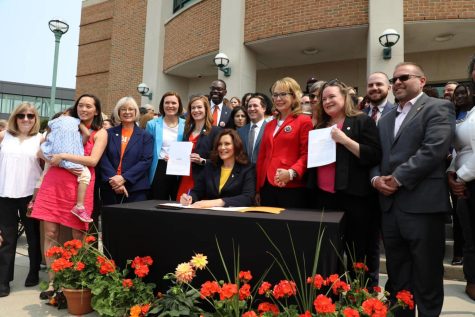Bloomfield Hills voters split on millage proposal
On Nov. 2, eligible voters will head to the polls to cast their votes for various candidates in local and national races around the state and country. However, the ballot is not confined to choices for office. Proposals, statewide and municipal, will need a yes or no vote.
This year, Bloomfield Hills and Bloomfield Township voters are faced with a tough decision regarding two millage proposals from the Bloomfield Hills School District. The first is a renewal millage for the sinking fund of Bloomfield Hills, which maintains schools in the district. The second proposal states that the money accumulated, by the annual millage, will go toward erecting new facilities and improving the current site of Andover High School.
Cynthia von Oeyen, treasurer for the Bloomfield Hills School Board, said there needs to be a very substantial renovation.
“The infrastructure (of the high school) was not created in a time when technology was what it is today,” von Oeyen said. “The spaces we use in the classroom are not conducive to the kind of group learning that is typical in today’s classroom.”
While the millage improves existing schools, there are disadvantages to the bond proposal that have spawned two conflicting groups: Bloomfield NOW (For) and Bloomfield 20/20 (Against).
Jenny Greenwell, member of Bloomfield 20/20 and former member of the BHSB, said there is no need to raise taxes with more millages.
“What is on the ballot are two tax proposals,” said Greenwell. “We have no idea what they plan to do with the money if a YES, YES vote prevails.”
Millages are determined by one’s property value. The millage rate is multiplied by the property value and then divided by 1,000. The end result is the amount one pays to the municipal district.
For example, if a property owner has property appraised at $100,000 and the second proposed millage passed for 1.43 mills — the amount of the millage on the ballot this November — then the owner is required to pay $143 every year.
Betsy Erikson, Bloomfield Hills Schools director of communications and communications relations, said AHS and Lahser High School will be hard to merge, but it is necessary so the district needs to improve AHS. AHS and LHS are the only two secondary education facilities in the district. LHS is set to close in 2012.
The district did an analysis in 2003 with the engineering firms of George Auch Company and P.M.P. Associates and identified $123 million in needed maintenance repair, said Erikson.
The sinking fund is currently at 1.4834 mills and expires in 2014. The proposed sinking fund millage on the ballot will begin in 2014 and levy 0.74 mills for a period of five years.
The BHSD bonding proposal, if it passes, will authorize a 1.43 mill levy. The proposal states the millage will begin with the acquiring of the bond, which the mill will pay for, in 2015. The bond may not be outstanding for 30 years beyond that date implying the millage cannot be enforced past 2045. The amount borrowed cannot exceed $73,025,000.
“We are asked to vote to approve it now,” said Greenwell. “Meanwhile, we will incur additional debt, as the BHSD will need to borrow money to get the construction started.”
Chris Fellin, treasurer of Bloomfield 20/20, said, “The overall cost of building the new high school is $105 million.”
“We will be using $20 million from the sinking fund, and $12 million from the Capital Improvement Fund,” Erikson said. The CIF is a savings fund for the district.
“I am concerned that there is no plan for this building,” Fellin said. “It seems we are signing a blank check and handing it over the school board.”
It is true that the BHS does not have a formal plan in place, however, BHS has chosen Field Nair International to design the building, said Erikson. She said the design will take six months to complete, and we should have 80 percent of the schematics complete by April.
“It is very normal in schools and policies to approach a plan in this way,” von Oeyen said. “We do not spend dollars on details of plans without voter approval.”







